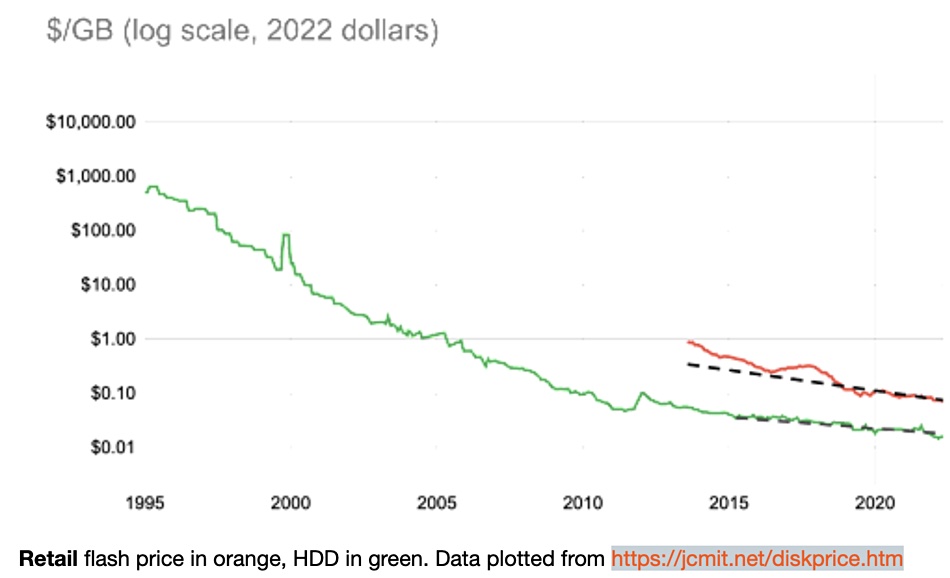A Pure Storage blog by FlashBlade Evangelist Justin Emerson declares “The Disk/Flash Crossover Event Is Closer Than You Think” and looks at the elements that could render hard drives the less cost-effective option.
He highlights a statement by Pure’s VP of hardware engineering, Pete Kirkpatrick: “For the last 15 years, it has always been the next [hard drive] tier to fall, but now there is only one tier left, and only one reason left to use disk, and that’s cost. With this crossover, it will be the last tier of drives to fall.”
Emerson declares: “As NAND price-per-bit continues to decline – at a rate much faster than nearline hard drives – that, combined with the power, space, and cooling savings, higher performance … and better reliability will soon render hard drives the less cost-effective option when taking all these elements into consideration.” He charts SSD vs HDD $/GB pricing declines using NewEgg data:

As we can see with the dotted trend lines the retail flash price is declining faster than the retail HDD price. We note that NewEgg is a computer equipment retailer and so not an enterprise and hyperscaler nearline drive seller.
Emerson says flash $/TB will continue to decline because, firstly, more layers can be added to 3D NAND and, secondly, PLC (5 bits/cell penta level cell) flash will increase density faster than cost of manufacture. He writes: “Moving from four to five bits per cell would improve density by 25 percent, which presents an obvious cost-efficiency advantage.”
He adds that SSDs are more energy-efficient than disk drives: “Pure’s energy efficiency will be a leading factor in enabling Pure Storage products to achieve a lower TCO than disk in the future.” Flash’s higher performance provides a resiliency cost advantage: “With flash devices, faster rebuild times mean less bits need to be dedicated to resiliency structures, which equates to better effective cost efficiency.”
SSDs are also more reliable than disk, failing less often, and: “If drives are more reliable, this goes into the same resiliency considerations as above.”
All these things lead Emerson to say: “In almost every way, flash memory is superior to spinning magnetic storage, and where flash is already better, those advantages are increasing. Where flash is still behind disk is cost, and the road to the disk/flash crossover point is getting shorter and shorter – and Pure Storage is at the front of the convoy. While it may not be the most ambitious crossover event in history, it will certainly be one of the most consequential for datacenters, for the IT industry, and for the world.”
A Toshiba exec takes a different view from Emerson, asserting that SSD replacement momentum has stalled as SSD $/TB price falls have slowed and are more or less parallel with HDD $/TB declines.
Also Seagate CTO John Morris told us in February 2021 that the flash and hard disk industries are both forecasting cost per bit improvements of about 20 per cent a year. If those expectations pan out, “we’re going to stay roughly in equilibrium in terms of rough cost per bit for the foreseeable future.” This view is shared publicly by some of the large cloud companies, he adds.
Emerson doesn’t mention the adoption of energy-assisted recording technologies by the disk drive manufacturers, such as Seagate’s HAMR and Toshiba and Western Digital’s MAMR. If these three can continue to demonstrate to enterprises and hyperscsalers that HDD cost/TB declines can match or poissibly exceeed SSD cost declines then Emerson’s blog will be forgotten.
But if energy usage and cost becomes increasingly important as a buying consideration then the scales could tilt in flash’s – and Pure’s – favor.








